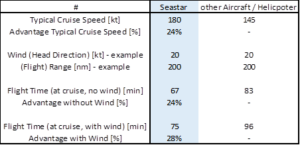Amphibious aircraft have a similar role as helicopters, in terms of short to medium range and haul operations. However, while helicopters in a similar class have typical cruise speed around 145 kTAS, the Seastar can cruise up to 180 KTAS (in FL 100), which is an advantage of 24%.
Thanks to the aerodynamic efficiency of a flying boat, the Seastar offers not only comfort but also the advantage for the passengers to reach their destination faster, and the commercial operators to increase their daily trip efficiency.
The advantage of speed is even more prominent when the wind counters your heading, which is almost inevitable in maritime environments. When you fly slowly, wind has a significant impact compared to high speeds. As an example, when one encounter 20kt head wind in a 200nm flight trip,the advantage rise from 24% to 28% – another 4% advantage.
This advantage of 28% means also 28% less operating cost for the same flight distance.
The following table summarize a typical trip with no influence of wind, compared to the same trip with the wind influence:

Table source: Dornier Seawings GmbH
From the table you can see, the advantage of speed can be an immense factor.
How is this achieved?
The high cruising speed of the Seastar, can be performed due the use of an innovative and efficient drive of 2 PT6 turbines in tandem, push-pull configuration, together with new design 5 blade composite MT Propeller.
The advantage of the tandem engine configuration is that the aerodynamic drag of usually 2 engine nacelles is reduced to one longer nacelle, with higher Reynolds number (lower drag) and lower drag relevant cross section.
Additionally the aerodynamic concept is supported by the so-called flying boat design, which is a more efficient aerodynamic design compared to float planes and helicopters, which further enables higher cruise speeds at the same power ratio.
The special Dornier design of the wing planform reduces the induced drag at the wing tips, similar to modern so called winglets, or sharklets, which increase also the aerodynamic efficiency of the wing.
The small sponsons or “seawings” are hydro-dynamically designed to have an ideal water handling ability with a minimum of additional aerodynamic effects.
All those features together, make the Seastar to the fastest amphibious aircraft in its class.
The Dornier Seastar. A Star is Born.


